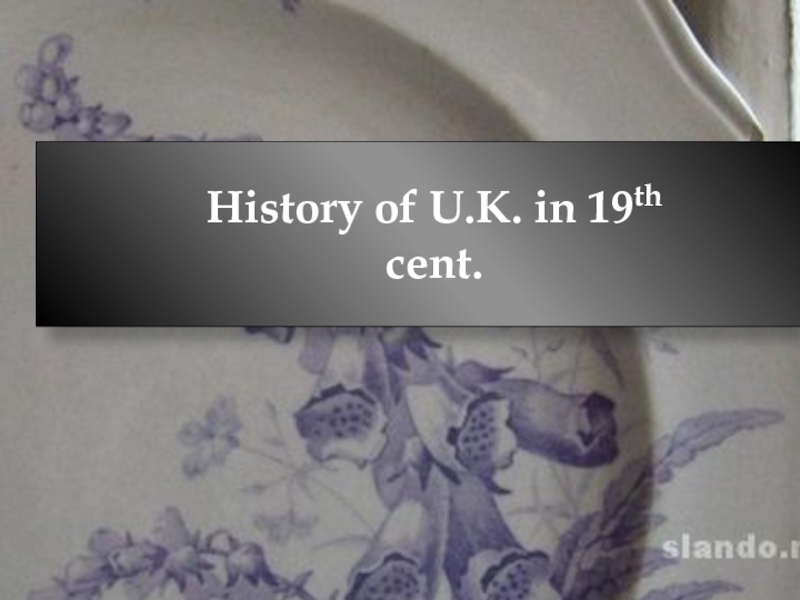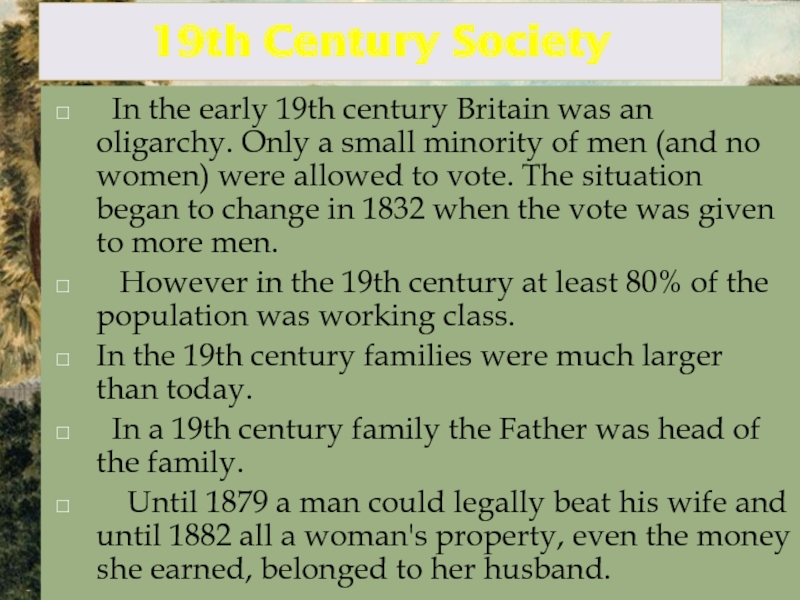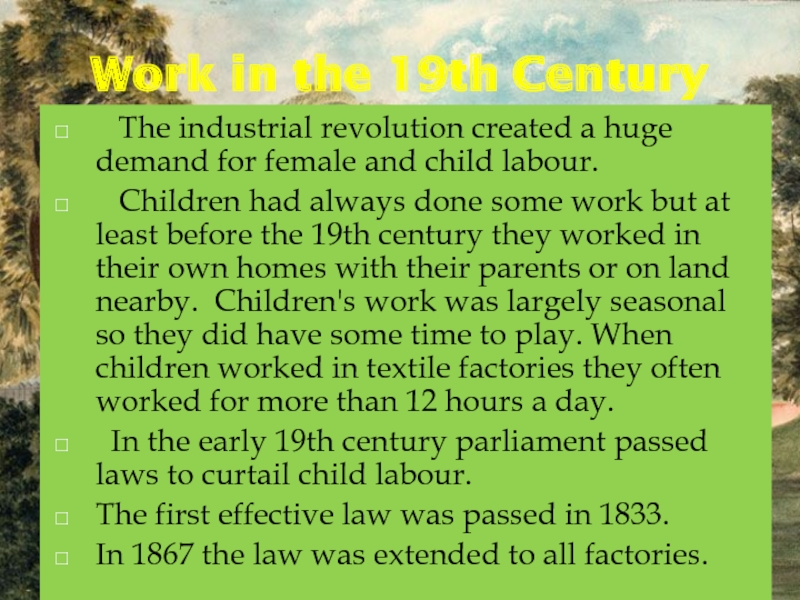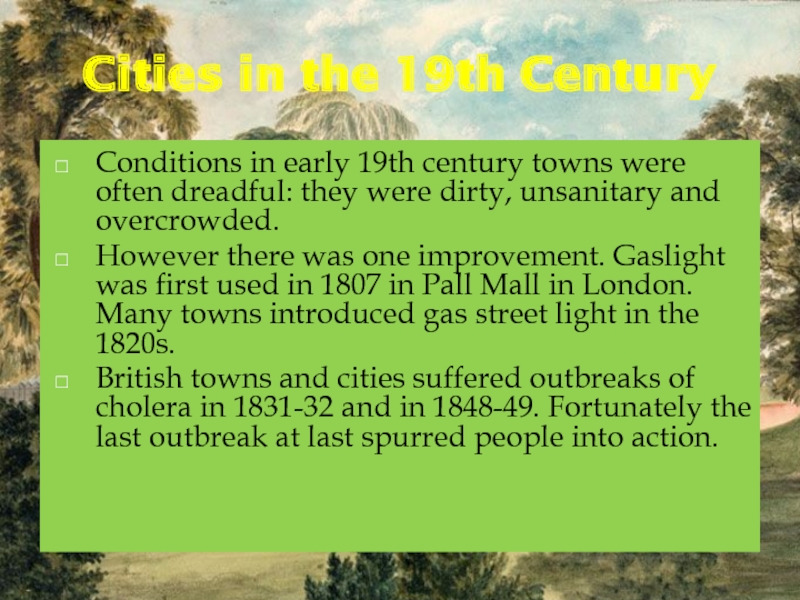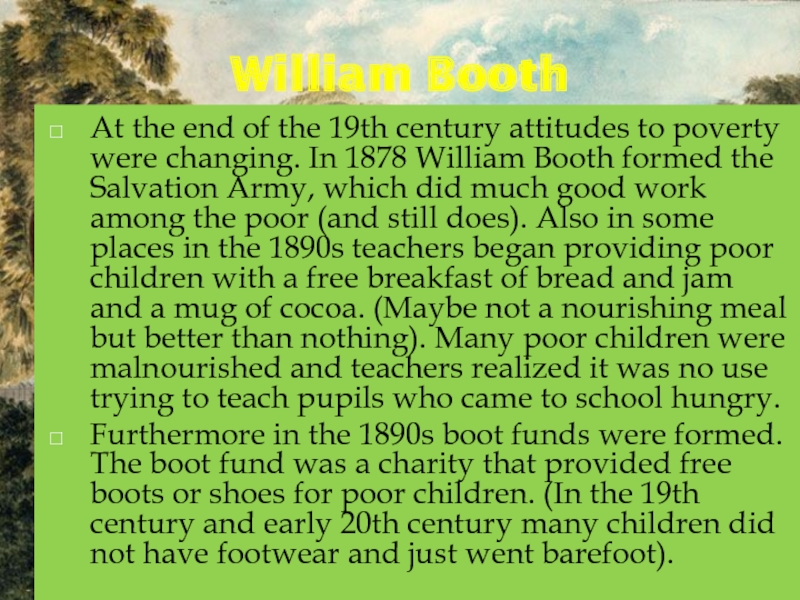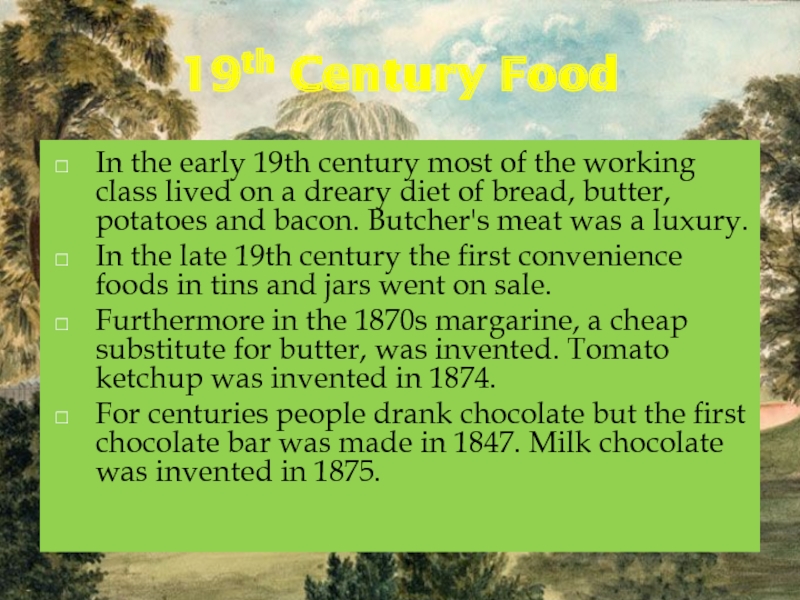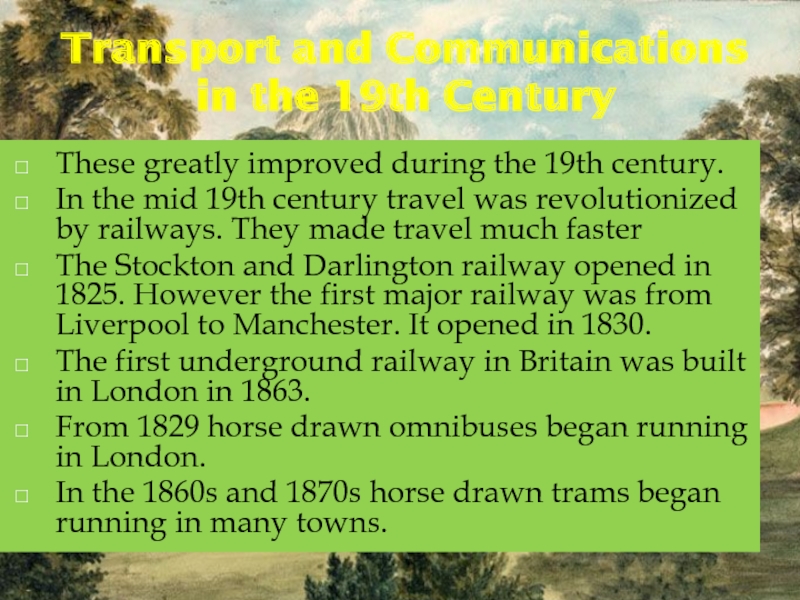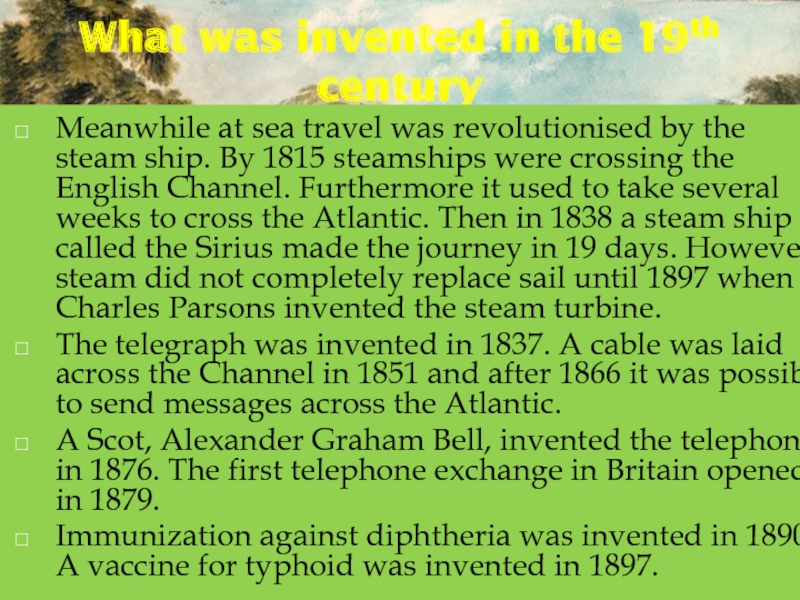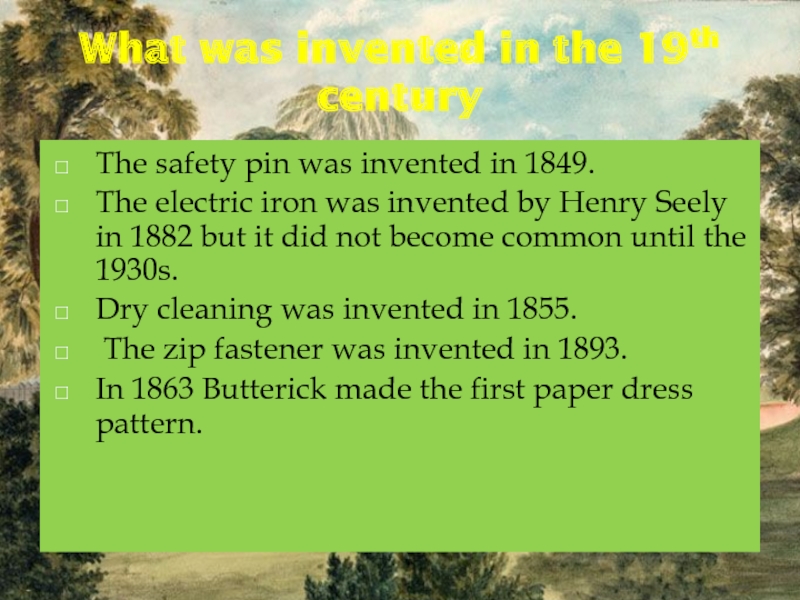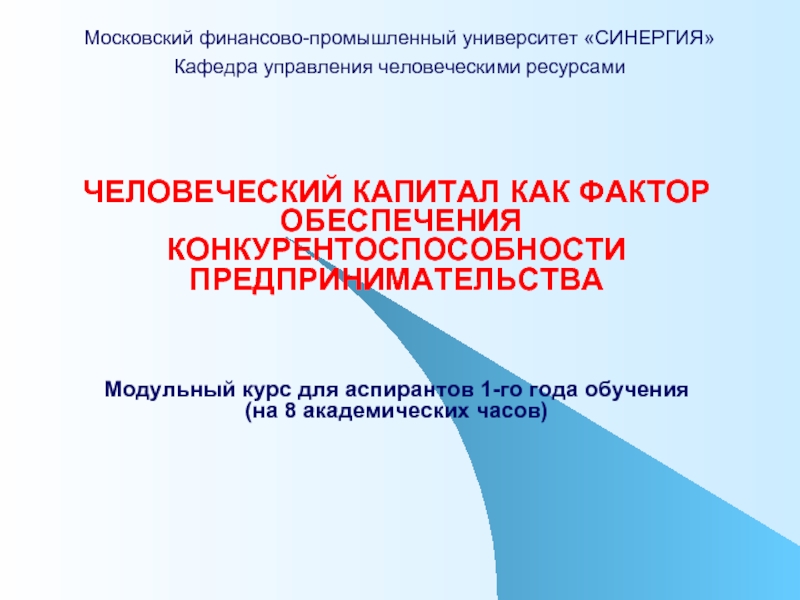- Главная
- Разное
- Дизайн
- Бизнес и предпринимательство
- Аналитика
- Образование
- Развлечения
- Красота и здоровье
- Финансы
- Государство
- Путешествия
- Спорт
- Недвижимость
- Армия
- Графика
- Культурология
- Еда и кулинария
- Лингвистика
- Английский язык
- Астрономия
- Алгебра
- Биология
- География
- Детские презентации
- Информатика
- История
- Литература
- Маркетинг
- Математика
- Медицина
- Менеджмент
- Музыка
- МХК
- Немецкий язык
- ОБЖ
- Обществознание
- Окружающий мир
- Педагогика
- Русский язык
- Технология
- Физика
- Философия
- Химия
- Шаблоны, картинки для презентаций
- Экология
- Экономика
- Юриспруденция
History of U.K. in 19thcent. презентация
Содержание
- 1. History of U.K. in 19thcent.
- 2. LIFE IN THE 19th CENTURY In the
- 3. 19th Century Society In the early
- 4. Work in the 19th Century
- 5. Cities in the 19th Century Conditions in
- 6. Poverty in the 19th Century The worst
- 7. William Booth At the end of
- 8. 19th Century Food In the early 19th
- 9. Transport and Communications in the 19th Century
- 10. What was invented in the 19th century
- 11. What was invented in the 19th century
Слайд 2LIFE IN THE 19th CENTURY
In the 19th century Britain became the
world's first industrial society.
It also became the first urban society. By 1851 more than half the population lived in towns.
The population of Britain boomed during the 19th century. In 1801 it was about 9 million. By 1901 it had risen to about 41 million.
This was despite the fact that many people emigrated to North America and Australia to escape poverty. About 15 million people left Britain between 1815 and 1914.
It also became the first urban society. By 1851 more than half the population lived in towns.
The population of Britain boomed during the 19th century. In 1801 it was about 9 million. By 1901 it had risen to about 41 million.
This was despite the fact that many people emigrated to North America and Australia to escape poverty. About 15 million people left Britain between 1815 and 1914.
Слайд 319th Century Society
In the early 19th century Britain was an
oligarchy. Only a small minority of men (and no women) were allowed to vote. The situation began to change in 1832 when the vote was given to more men.
However in the 19th century at least 80% of the population was working class.
In the 19th century families were much larger than today.
In a 19th century family the Father was head of the family.
Until 1879 a man could legally beat his wife and until 1882 all a woman's property, even the money she earned, belonged to her husband.
However in the 19th century at least 80% of the population was working class.
In the 19th century families were much larger than today.
In a 19th century family the Father was head of the family.
Until 1879 a man could legally beat his wife and until 1882 all a woman's property, even the money she earned, belonged to her husband.
Слайд 4Work in the 19th Century
The industrial revolution created a
huge demand for female and child labour.
Children had always done some work but at least before the 19th century they worked in their own homes with their parents or on land nearby. Children's work was largely seasonal so they did have some time to play. When children worked in textile factories they often worked for more than 12 hours a day.
In the early 19th century parliament passed laws to curtail child labour.
The first effective law was passed in 1833.
In 1867 the law was extended to all factories.
Children had always done some work but at least before the 19th century they worked in their own homes with their parents or on land nearby. Children's work was largely seasonal so they did have some time to play. When children worked in textile factories they often worked for more than 12 hours a day.
In the early 19th century parliament passed laws to curtail child labour.
The first effective law was passed in 1833.
In 1867 the law was extended to all factories.
Слайд 5Cities in the 19th Century
Conditions in early 19th century towns were
often dreadful: they were dirty, unsanitary and overcrowded.
However there was one improvement. Gaslight was first used in 1807 in Pall Mall in London. Many towns introduced gas street light in the 1820s.
British towns and cities suffered outbreaks of cholera in 1831-32 and in 1848-49. Fortunately the last outbreak at last spurred people into action.
However there was one improvement. Gaslight was first used in 1807 in Pall Mall in London. Many towns introduced gas street light in the 1820s.
British towns and cities suffered outbreaks of cholera in 1831-32 and in 1848-49. Fortunately the last outbreak at last spurred people into action.
Слайд 6Poverty in the 19th Century
The worst thing about poverty in the
19th century was the callous attitude of many Victorians. They were great believers in 'self-help'. That is they thought everyone should be self-reliant and not look to other people for help.
At the end of the 19th century more than 25% of the population was living at or below subsistence level. Surveys indicated that around 10% were very poor and could not afford even basic necessities such as enough nourishing food. Between 15% and 20% had just enough money to live on (provided they did not lose their job or have to take time off work through illness).
At the end of the 19th century more than 25% of the population was living at or below subsistence level. Surveys indicated that around 10% were very poor and could not afford even basic necessities such as enough nourishing food. Between 15% and 20% had just enough money to live on (provided they did not lose their job or have to take time off work through illness).
Слайд 7William Booth
At the end of the 19th century attitudes to
poverty were changing. In 1878 William Booth formed the Salvation Army, which did much good work among the poor (and still does). Also in some places in the 1890s teachers began providing poor children with a free breakfast of bread and jam and a mug of cocoa. (Maybe not a nourishing meal but better than nothing). Many poor children were malnourished and teachers realized it was no use trying to teach pupils who came to school hungry.
Furthermore in the 1890s boot funds were formed. The boot fund was a charity that provided free boots or shoes for poor children. (In the 19th century and early 20th century many children did not have footwear and just went barefoot).
Furthermore in the 1890s boot funds were formed. The boot fund was a charity that provided free boots or shoes for poor children. (In the 19th century and early 20th century many children did not have footwear and just went barefoot).
Слайд 819th Century Food
In the early 19th century most of the working
class lived on a dreary diet of bread, butter, potatoes and bacon. Butcher's meat was a luxury.
In the late 19th century the first convenience foods in tins and jars went on sale.
Furthermore in the 1870s margarine, a cheap substitute for butter, was invented. Tomato ketchup was invented in 1874.
For centuries people drank chocolate but the first chocolate bar was made in 1847. Milk chocolate was invented in 1875.
In the late 19th century the first convenience foods in tins and jars went on sale.
Furthermore in the 1870s margarine, a cheap substitute for butter, was invented. Tomato ketchup was invented in 1874.
For centuries people drank chocolate but the first chocolate bar was made in 1847. Milk chocolate was invented in 1875.
Слайд 9Transport and Communications in the 19th Century
These greatly improved during the
19th century.
In the mid 19th century travel was revolutionized by railways. They made travel much faster
The Stockton and Darlington railway opened in 1825. However the first major railway was from Liverpool to Manchester. It opened in 1830.
The first underground railway in Britain was built in London in 1863.
From 1829 horse drawn omnibuses began running in London.
In the 1860s and 1870s horse drawn trams began running in many towns.
In the mid 19th century travel was revolutionized by railways. They made travel much faster
The Stockton and Darlington railway opened in 1825. However the first major railway was from Liverpool to Manchester. It opened in 1830.
The first underground railway in Britain was built in London in 1863.
From 1829 horse drawn omnibuses began running in London.
In the 1860s and 1870s horse drawn trams began running in many towns.
Слайд 10What was invented in the 19th century
Meanwhile at sea travel was
revolutionised by the steam ship. By 1815 steamships were crossing the English Channel. Furthermore it used to take several weeks to cross the Atlantic. Then in 1838 a steam ship called the Sirius made the journey in 19 days. However steam did not completely replace sail until 1897 when Charles Parsons invented the steam turbine.
The telegraph was invented in 1837. A cable was laid across the Channel in 1851 and after 1866 it was possible to send messages across the Atlantic.
A Scot, Alexander Graham Bell, invented the telephone in 1876. The first telephone exchange in Britain opened in 1879.
Immunization against diphtheria was invented in 1890. A vaccine for typhoid was invented in 1897.
The telegraph was invented in 1837. A cable was laid across the Channel in 1851 and after 1866 it was possible to send messages across the Atlantic.
A Scot, Alexander Graham Bell, invented the telephone in 1876. The first telephone exchange in Britain opened in 1879.
Immunization against diphtheria was invented in 1890. A vaccine for typhoid was invented in 1897.
Слайд 11What was invented in the 19th century
The safety pin was invented
in 1849.
The electric iron was invented by Henry Seely in 1882 but it did not become common until the 1930s.
Dry cleaning was invented in 1855.
The zip fastener was invented in 1893.
In 1863 Butterick made the first paper dress pattern.
The electric iron was invented by Henry Seely in 1882 but it did not become common until the 1930s.
Dry cleaning was invented in 1855.
The zip fastener was invented in 1893.
In 1863 Butterick made the first paper dress pattern.
